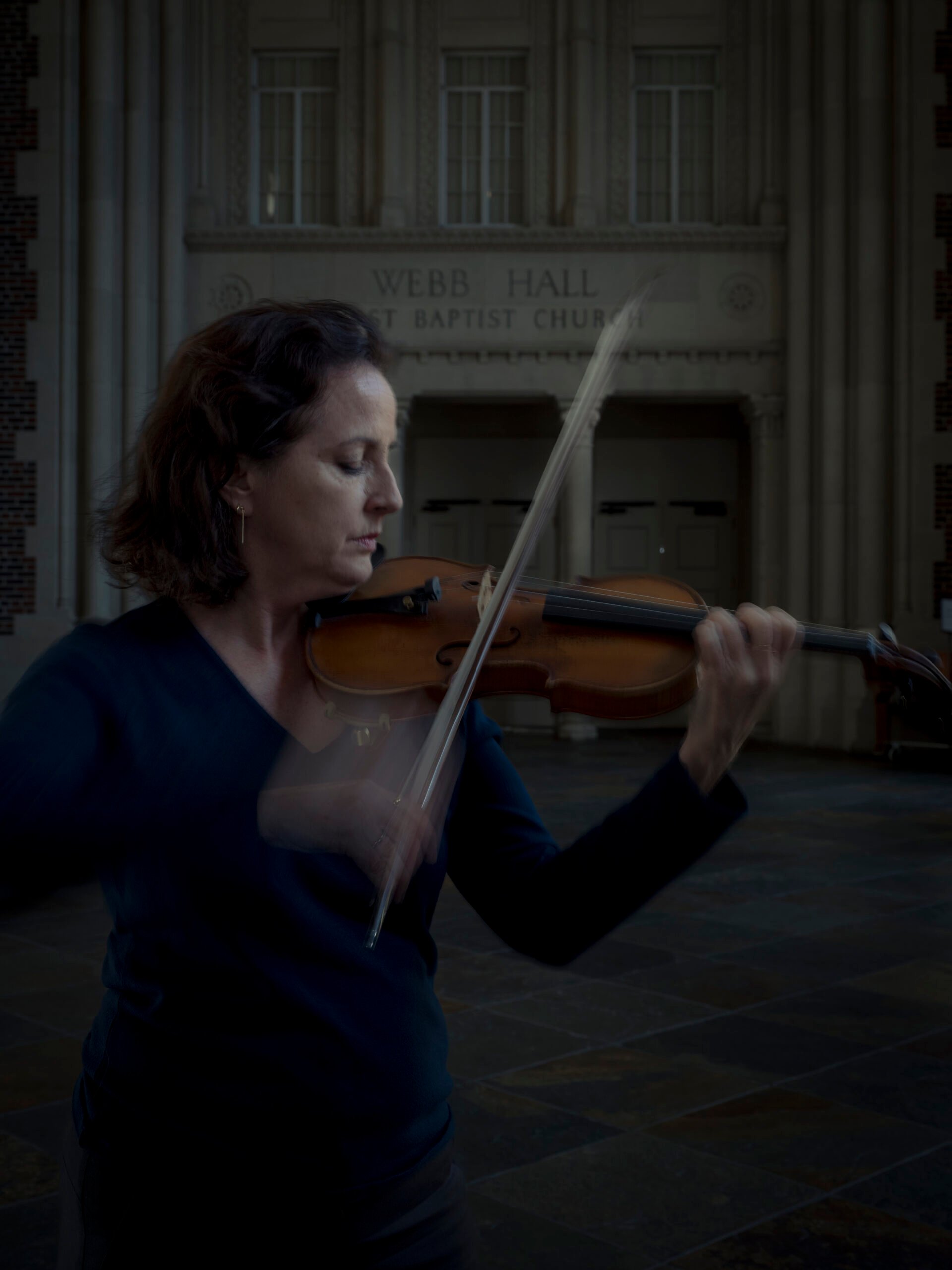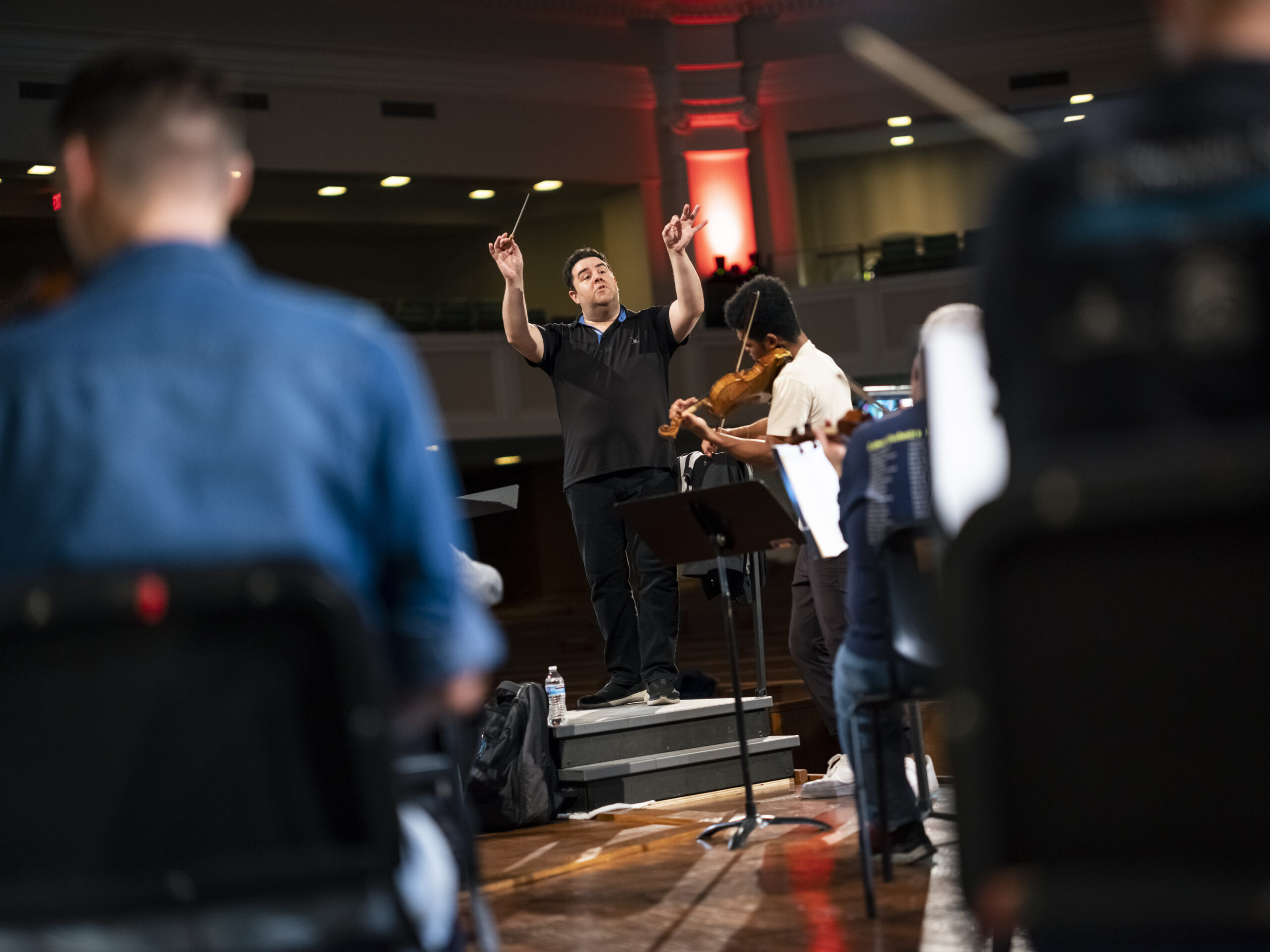It’s chill and starless in downtown San Antonio on symphony night. Just past the Express-News offices and across from the Tobin Center for the Performing Arts, I arrive at the century-old First Baptist Church building. The ushers’ faces light up as the crowd arrives. I see mostly gray-haired Anglos filing in, though not entirely. The 1,200-seat sanctuary, domed and dotted with stained glass, fills up maybe 60 percent—prior performances nearly packed the house, I’m told—as around 65 musicians with the San Antonio Philharmonic warm up on stage.
The show tonight is not Beethoven or Mozart but a “pops” concert, a tribute to Martin Luther King including spirituals and renditions of King’s rhetoric. It’s been 11 days since the city’s annual MLK March, and renowned conductor Charles Floyd, one of few Black artists in his position, is in town to lead the show. Floyd guides the ensemble through works including the Afro-American Symphony, a 90-year-old composition ranging from jazzy to martial to tranquil. Cellists’ fingers fly like butterflies up fingerboards and violinists’ bows jab the air in unison. There’s little sign, to the untrained ear at least, that this is an orchestra lately snatched from the brink.
Launched in August 2022, the Philharmonic was previously known as the Musicians of the San Antonio Symphony Performance Fund, itself a makeshift group that put on performances last year while the 83-year-old Symphony Society of San Antonio—Texas’ longest-running professional orchestra—imploded. Following a nine-month labor strike by the symphony’s unionized musicians, the storied organization declared bankruptcy and dissolved last summer, raising the specter of San Antonio as America’s largest city without a symphony. The orchestra’s demise culminated decades of strife between the nonprofit’s workers and its board and management. Since at least the 1980s, symphony leadership insisted San Antonio was an artistically stingy town, unwilling or unable to pony up for a full-fledged orchestra of well-paid players, while performers pointed the finger back at administrative incompetence and possible anti-union hostility. The organization lurched from crisis to crisis; the musicians soldiered on, typically excellent and paid beans.
The Philharmonic’s present fight for a foothold isn’t just about preserving the classical music tradition in Texas’ second-largest city. It’s about the quality of kids’ musical education, the position of organized labor, and San Antonio’s status as a major metropolis. For now, the group isn’t playing in the venue it ultimately wants; the budget isn’t what it needs to be; and it might have new competition for seemingly scarce public and private dollars. But Brian Petkovich, both a Philharmonic bassoonist and the organization’s board president, would like Alamo City residents to focus chiefly on the music.
“Basically, the musicians wanted to persevere,” said Petkovich, who joined the San Antonio Symphony in 1996. “All the machinations about venue and who’s supporting and who’s not supporting … that is not as important as [that] we are doing great concerts for people and improving their lives.”
At the MLK tribute, visiting bass-baritone Timothy Jones takes the stage. His voice, operatic and canyon-deep, courses like a river from which the orchestra’s higher notes emerge. He draws a standing ovation with a trio of old spirituals. He sings the “I Have a Dream” speech and concludes by leading the audience, heartily, in “We Shall Overcome.” Loose cheers and bravos ring.
Pouring out of the sanctuary, the happy burble that follows a well-enjoyed show clings to the crowd. Snatches of conversation about which part was best flit past as we emerge into a cold drizzle. Frankly, it was moving music. It didn’t require a sophisticated understanding of the classical repertoire to enjoy. I can’t say my eyes stayed entirely dry.
San Antonio owes its symphonic history to a refugee. In the late 1930s, German-Italian conductor Max Reiter fled rising fascism in Europe and, hearing that Steinway pianos were selling well in Texas, left New York for the Lone Star State. The San Antonio Symphony’s first performance was at the Sunken Garden Theater in 1939, and by the mid-’40s the ensemble ranked among the country’s best.
“Until we hear a better symphony, we shall call San Antonio’s the finest developed in this part of the country,” wrote legendary Dallas Morning News critic John Rosenfield in 1945. Or, as former longtime Express-News critic Mike Greenberg told me, “San Antonio was the place [in Texas] for classical music in the 1940s and 50s.”

Trouble arrived, though, by the 1980s. In a masterly 1987 Texas Monthly feature, Lawrence Wright depicted what led to a strike, a lockout, and a short-lived musician-run orchestra in the mid-’80s. An aged base of supporters from the city’s Anglo North Side was declining, while symphony leadership moved into the hands of business types who saw the orchestra more as an amenity to lure corporations than a vehicle for a hallowed musical tradition, Wright wrote. The symphony managers wanted to cut pay for musicians, already paid less than schoolteachers, and shrink the size of the 81-player orchestra. Wright also argued that as the city’s Latino majority grew in strength, symphony advocates found themselves competing for government assistance—an important portion of many orchestral budgets—“with Mexican labor organizers in blue jeans and West Side mothers who had city sewage backing up into their houses.”
Symphony musicians bristle at shrinking their orchestras or converting employees to contractors, arguing a full complement of 70-100 full-time musicians is key to performing the classical repertoire and attracting top-notch talent. Ultimately, the two sides in the ’80s dispute hammered out terms to keep the symphony intact, but the fight presaged what one musician told me was “30-plus years of instability,” including another lockout in the ’90s and a bankruptcy in the early aughts.
“They’re definitely an outlier,” said Drew McManus, a Chicago-based orchestra consultant, regarding San Antonio’s symphony. “Most orchestras have not demonstrated the sort of strife that that orchestra had for as long of a period of time as they had.”
In broad strokes, McManus said America’s symphonies ascended through the latter half of last century into the 2000s. The Great Recession shook the industry as live music fell prey to other competitors as well; boards and bosses demanded austerity, and strikes and bankruptcies blossomed. Some orchestras recovered well, while others didn’t. The same has proven true for the COVID-19 pandemic. For McManus, there’s no secret of geography or demography to explain each outcome. Instead, it all hinges on matters of good nonprofit governance and each idiosyncratic network of leadership, donors, elected officials, and audience.
McManus said he sees nothing inherent to San Antonio that should keep it from maintaining a full-fledged orchestra that’s paid a “living wage.”
Symphonic orchestras are a small but solid stronghold for organized labor in America.
“Any orchestral musician worth a damn is a member of the [labor union the American Federation of Musicians],” said Richard Oppenheim, president of AFM Local 23, which represents San Antonio’s symphony players. “We’re about as locked down a segment of an industry as you’re ever going to find.”
So when orchestral musicians go on strike—as they did in San Francisco in 2013, Fort Worth in 2016, and Chicago in 2019—symphony leaders have few means of bringing in “scabs.” The standoff generally holds, as performance weeks disappear, until both sides make concessions. Rarely do the curtains close for good.
In 2019, the Symphony Society of San Antonio and the AFM inked a three-year contract under which the ensemble’s 72 musicians made a minimum yearly salary of about $36,000. When the pandemic struck, truncating the ongoing season, musicians agreed to an 80 percent pay cut for the upcoming year so the organization could weather the storm. Workers further agreed the deal’s third year could be renegotiated should the pandemic require. Management reopened the contract in January 2021.
Over the next eight months, symphony leadership variously proposed slashing salaries by thousands and the number of musicians by dozens, aiming at an annual budget of about $5 million—a dropoff from the $6-8 million the organization raised in years prior to the pandemic—even though the symphony received and was forgiven $1.9 million in federal Paycheck Protection Program loans. In September 2021, management declared an “impasse” and unilaterally imposed one of its spartan propositions, prompting the players to strike. Musicians then put on a handful of shows themselves at the downtown Baptist church; negotiations continued with no breakthrough in sight.
In interviews with the San Antonio Report and Texas Public Radio, then-Executive Director Corey Cowart claimed a $5 million budget would be sustainable, allowing leadership to woo patrons wary of the group’s volatility. Then-board Chair Kathleen Weir Vale said corporate donors wanted to see “a financially viable organization” before giving. Cowart declined to be interviewed for this story, and Vale did not answer requests.
Mary Ellen Goree, a violinist for the symphony since 1988 and then-leader of negotiations for the musicians, called bullshit.
“The metro area of San Antonio is of a size and population that you cannot mathematically say we can’t support a professional orchestra,” she said. “The justification was usually that San Antonio is a low-income city and that the demographics were not favorable; I will not dig into the covert racism of the second statement, except to point out that Mexico City has five professional orchestras.”
“The justification was usually that San Antonio is a low-income city and that the demographics were not favorable; I will not dig into the covert racism of the second statement, except to point out that Mexico City has five professional orchestras.”
The San Antonio metro area, about 56 percent Latino and 13 percent poor, has a population of 2.6 million, putting it in league with cities like St. Louis, Cincinnati, and Kansas City. These metros have slightly lower poverty rates, but their yearly symphony revenues are often four to 10 times the budget San Antonio’s management was proposing. Plus, San Antonio is among the nation’s fastest-growing cities. Closer to home, the Fort Worth symphony routinely raises $10-15 million, while Goree said San Antonio musicians were fighting for a budget of only about $8 million. Any inability to hit that mark, Goree and others believe, stemmed from failures of fundraising and marketing.
For Oppenheim, the union president, more nefarious forces may have also been at work: Big-money brokers, set on withholding money unless the orchestra was gutted, who’ve “really worked so hard to just throttle this union over the years.”
Oppenheim specifically hearkens back to 2017, when a trio of major symphony backers—Tullos Wells, an attorney and head of the Kronkosky Charitable Foundation; Dya Campos, government affairs director for H-E-B; and Bruce Bugg, chair of the Tobin Endowment and Governor Greg Abbott appointee to the state transportation board—nearly took over symphony operations under a new organization. The deal fell apart when, the group said, it discovered an unfunded liability to the AFM pension. But, had it gone through, the plan was to impose essentially the same cutbacks and budget management later proposed in 2021.
Campos declined an interview request, and Bugg did not respond. Reached by phone, Wells—who was previously advertised on his law firm’s website as having “experience in union avoidance”—clarified that his group in 2017 had no ambitions to jettison the union but rather to “recognize the AFM and then [to] bargain for things they would not like.”
“There had to be fiscal discipline imposed. … This community has not and is not going to support an $8-8.5 million symphony; it may someday, I think it should; if it were up to me it would,” Wells said. Following his deal’s collapse, he said, the symphony continued to budget unrealistically, setting up the 2021 crisis.
In June 2022, with bargaining stuck, the nonprofit’s board declared the end of the San Antonio Symphony’s eight-decade existence, and two months later the orchestra’s musicians unveiled the Philharmonic. As for Wells, he said that for his organization to fund the new symphony, he’d need to see a plan similar to his group’s from 2017.
The fate of the San Antonio Philharmonic matters beyond the closing notes of their performances. The group provides free shows at San Antonio schools, and most of the players teach, not just to complement their meager salaries but also for love of passing on the craft. These instructors largely moved to San Antonio for the symphony.
“Mentors are the lifeblood of music education” for kids serious about a classical instrument, “and in every city those mentors tend to be the professional orchestra musicians of that city,” said Troy Peters, music director of Youth Orchestras of San Antonio. “There’s no question that the musicians of the San Antonio Philharmonic are this civic treasure.”

The fledgling orchestra raised about $1.2 million last calendar year, per board President Petkovich, and its inaugural season is set to run through May. Time will tell if the Philharmonic, which needs to expand both staff and board, can grow into the sort of budget many San Antonio musicians always believed possible.
Then there’s the matter of venue. The Baptist church is a solid location, but a better-fitting facility sits just across the road: the Tobin Center, with its H-E-B Performance Hall acoustically suited for a large orchestra. Funded with $100 million in county bonds approved by voters in 2008, the Tobin opened in 2014 with the symphony as a resident company, a status providing favorable rental rates and priority booking. At one early performance, conductor Sebastian Lang-Lessing announced, “We’re finally home.” The symphony played there through 2021, but the Tobin did not recognize the striking musicians last year as a resident company and has not done so for the San Antonio Philharmonic.
“The Philharmonic and these musicians belong in the Tobin Center; it was built with tax dollars and it was for that purpose, so I just find it very troubling,” said Roberto Treviño, an ex-city council member now on the Philharmonic board.
Via email, Tobin spokesperson Christopher Novosad said arts groups must have proven financial stability for three years to be considered for residency. “Being a world class symphonic artist does not equate to the ability to run and maintain a successful non-profit arts organization,” he wrote, adding the Tobin was “not built specifically for the symphony” but for all local arts. Novosad also identified a further obstacle for the Philharmonic: a recent spat between the AFM and another classical music group on the San Antonio scene.
In October, the Bexar County Commissioners Court provided $300,000 to the roughly decade-old nonprofit Classical Music Institute (CMI), which focuses on music education, to help it accompany Opera San Antonio and Ballet San Antonio, a role previously filled by the San Antonio Symphony. CMI, which also recently received $350,000 from Tullos Wells’ Kronkosky Foundation, relies on contracted musicians from out of town and has no union agreement. Oppenheim and other labor leaders condemned the decision, and County Commissioner Tommy Calvert, the sole “no” vote, told me it was “a union-busting move.”
The AFM then placed CMI, a resident company at the Tobin, on its “unfair list,” which discourages union players from working with a group, and the AFM picketed an opera rehearsal in November. CMI sued the union in a case that was resolved after CMI agreed to raise wages and the AFM removed the institute from its list.
Paul Montalvo, head of CMI, said in a phone call his group plans to grow from zero full-time musicians to around 40 in the next few years. He claimed most classical works can be played by a group that size, supplemented as needed with contractors. He also said good pay and benefits should make unionization unnecessary for CMI employees: “I don’t feel that it’ll be a thing for them to consider because of what we’re going to offer them.”
Asked whether his group was in competition with the Philharmonic, Montalvo said he thinks San Antonio can “support two organizations that are doing this, but then again I’m sort of the stargazer and dreamer.” He said he hopes CMI will continue to accompany the city’s ballet and opera—just as Petkovich said he hopes for his orchestra.
In December, the county did provide $325,000 to the Philharmonic, lessening the sting of the earlier decision. As of early March, the organization was still angling for city funds and finalizing the details of a collective bargaining agreement with the AFM. With active musicians on both sides, negotiations have reportedly been amicable.
Meanwhile, the Philharmonic is finding at least some new backers in town, bullish on their city and unjaded by the trials of the past.
Colette Holt, a civil rights attorney, moved to San Antonio in 2019 with her jazz percussionist husband, and the pair helped pay last fall for the Philharmonic to rescue the symphony’s instruments and sheet music amid the bankruptcy. The two have since become evangelists for the orchestra, working to gin up new donors. In Holt’s view, new residents and money are pouring into a San Antonio on the cusp of being a “world-class city,” and philanthropists simply need to see the symphony with fresh eyes.
“I’m sorry, but I come from Chicago and California; $8 million is no money to raise,” Holt said. “It just frustrates me, maybe because I am a transplant, I hear a lot here: ‘We can’t do this, we can’t do that,’ and I’m looking around and thinking, ‘Why not?’”
Update: On March 21, representatives of the Philharmonic and the AFM told the Observer that they had reached a first collective bargaining agreement.




